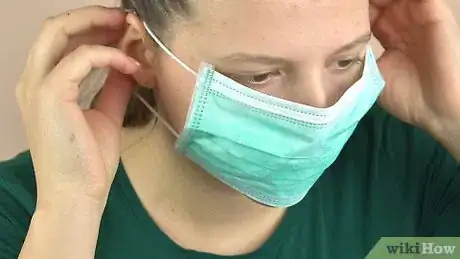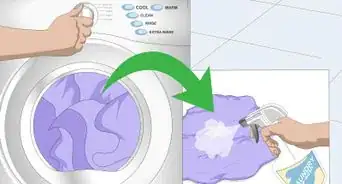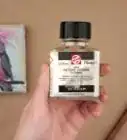This article was co-authored by Kelly Medford and by wikiHow staff writer, Janice Tieperman. Kelly Medford is an American painter based in Rome, Italy. She studied classical painting, drawing and printmaking both in the U.S. and in Italy. She works primarily en plein air on the streets of Rome, and also travels for private international collectors on commission. She founded Sketching Rome Tours in 2012 where she teaches sketchbook journaling to visitors of Rome. Kelly is a graduate of the Florence Academy of Art.
There are 7 references cited in this article, which can be found at the bottom of the page.
This article has been viewed 50,237 times.
If you’re starting a new art or home improvement project, you might be using oil-based paints to get the job done. While oil paint looks beautiful on a finished product, it can be a bit difficult to apply at first. If you’re working on a residential or commercial painting project, mix small amounts of turpentine or mineral spirits with the rest of your paint. If you’re an artistic painter, mix linseed oil and mineral spirits together to help apply your paint more smoothly to a canvas. With the right ratio of paint and thinning agent, you’ll be on your way to creating a vibrant final product.
Steps
Using Paint Thinner for Interiors and Exteriors
-
1Set up your painting supplies in a well-ventilated area. Slide on a respirator or breathing mask before working with any kind of paint thinner. Since these products give off harsh fumes, you don’t want to inhale any paint thinners directly. Additionally, set up a box fan that’s facing away from your painting area, so any fumes can swiftly leave the room.[1]
- If you’re painting outside, you should still wear a respirator or safety mask.
-
2Mix a 2:1 ratio of oil paint and turpentine for a thicker paint application. Pour your desired amount of paint into a painting tray. To give your paint a slightly thick consistency, combine 1 cup (240 mL) of turpentine or mineral spirits with 2 cups (470 mL) of oil-based paint.[2] Use a paint stirrer to mix the ingredients together so the paint has an even consistency.[3]
- Always use a 2:1 ratio of paint to paint thinner when creating a thicker mixture.
- These ratios work best for widespread paint application, like the exterior of a home.
Advertisement -
3Stir in more thinner to water down the paint. After pouring your paint into a tray, pour in a larger amount of turpentine or mineral spirits to dilute the mixture. For a thinner paint job, add in 2 cups (470 mL) of paint thinner into 1 cup (240 mL) of oil paint. Using a paint stirrer, mix these 2 substances together to create a watered-down base for your project.[4]
- Use a 1:2 ratio of oil-based paint and thinner whenever you make a thinner mixture.
- Thinner coverage can work well for exterior painting projects that involve a lot of whitewashing.
- Don’t add too much thinner at once. You can always make adjustments to your mixture later!
-
4Test out a small amount of paint before covering an entire surface. Before embarking on your project, try combining a small amount of paint and thinner together using your desired ratio. Use a small brush to paint over a tiny spot in your project, so you can see if you like the coverage or not. If the paint job looks good, continue painting over the rest of the surface.[5]
- Add thinner in small, tablespoon or milliliter increments when making adjustments to your mixture.
Combining Oil and Mineral Spirits for Art Projects
-
1Mix 1 part of linseed oil with 2 parts of mineral spirits in a jar. Pour 1 tablespoon (15 mL) or so of linseed oil into a small glass container to serve as the base for your medium. To thin out the oil, add 2 tablespoons (30 mL) of mineral spirits into the jar. Use a palette knife or other thin tool to stir these ingredients together. Store the medium in a small glass container.[6]
- Any drying oil will work for your medium, like walnut oil. Avoid using non-drying oils in your mixture, like coconut oil.
- If you anticipate needing more oil medium, feel free to increase the amounts in your ratio.
Did you know? A medium is a substance that lets you apply your paint to a surface in a unique, artistic way.
-
2Add small, even amounts of oil paint onto your palette. Use a palette knife to scoop a grape-sized amount of different-colored paints onto your palette. Keep these paints at least 1 in (2.5 cm) apart so the colors don’t bleed together on accident.[7]
- Always wipe off your palette knife before dipping into a different paint.
-
3Add 1-2 drops of your medium into each paint color. Take an eyedropper tool and squirt a couple drops of diluted oil into each mound of paint. Ideally, try squeezing the oil into the center of the paint, so it will be easier to mix in. Try adding the same amount of medium to each color, so your paint application looks consistent in your final product.[8]
- Don’t add too much oil medium at once. You can always add in more thinning agent if the paint is still too thick.
-
4Stir the ingredients together with a small palette knife. Take a palette knife and spin it through each paint color. Work the tool in round motions, so all the paint mixes in with the drops of oil medium. Continue flipping and rotating the knife until the paint is thoroughly mixed with the oil, and has a consistent texture throughout.[9]
- Wipe off the palette knife before stirring other paint colors.
Expert Q&A
-
QuestionHow do I make oil paint runny?
 Kelly MedfordKelly Medford is an American painter based in Rome, Italy. She studied classical painting, drawing and printmaking both in the U.S. and in Italy. She works primarily en plein air on the streets of Rome, and also travels for private international collectors on commission. She founded Sketching Rome Tours in 2012 where she teaches sketchbook journaling to visitors of Rome. Kelly is a graduate of the Florence Academy of Art.
Kelly MedfordKelly Medford is an American painter based in Rome, Italy. She studied classical painting, drawing and printmaking both in the U.S. and in Italy. She works primarily en plein air on the streets of Rome, and also travels for private international collectors on commission. She founded Sketching Rome Tours in 2012 where she teaches sketchbook journaling to visitors of Rome. Kelly is a graduate of the Florence Academy of Art.
Professional Artist Mix your oil paint with a little bit of turpentine to make it thinner and easier to use.
Mix your oil paint with a little bit of turpentine to make it thinner and easier to use.
wikiHow Video: How to Thin Oil Paint
Things You’ll Need
Using Paint Thinner for Interiors and Exteriors
- Respirator or mask
- Box fan
- Oil-based paint
- Turpentine or mineral spirits
- Paint stirrer or palette knife
Combining Oil and Mineral Spirits for Art Projects
- Linseed oil
- Mineral spirits
- Small glass jar
- Eyedropper tool
- Oil-based paint
- Palette
- Palette knife
References
- ↑ https://www.sugarlandtx.gov/422/Paint-Hazards
- ↑ Kelly Medford. Professional Artist. Expert Interview. 10 March 2021
- ↑ https://www.bobvila.com/articles/whitewashing/
- ↑ https://www.bobvila.com/articles/whitewashing/
- ↑ https://www.bobvila.com/articles/whitewashing/
- ↑ https://m.youtube.com/watch?v=z7DWCoS-eiE&t=6m15s
- ↑ https://m.youtube.com/watch?v=272nKSiEYB8&t=4m21s
- ↑ https://m.youtube.com/watch?v=z7DWCoS-eiE&t=11m5s
- ↑ https://m.youtube.com/watch?v=z7DWCoS-eiE&t=11m13s
About This Article
To thin oil paint for an art project, first mix 1 part linseed oil with 2 parts mineral spirits in a jar. Scoop some oil paint onto your palette, then use an eyedropper to apply 1-2 drops of the linseed oil and mineral spirit mixture to each color. Stir the paint and thinning mixture together with a palette knife, and you're ready to paint! To thin oil paint for a home improvement project, mix 2 parts oil paint with 1 part turpentine. Gradually stir in more turpentine until you reach your desired consistency. For more tips, like how to test the consistency of your oil paint before using it, keep reading!




















































